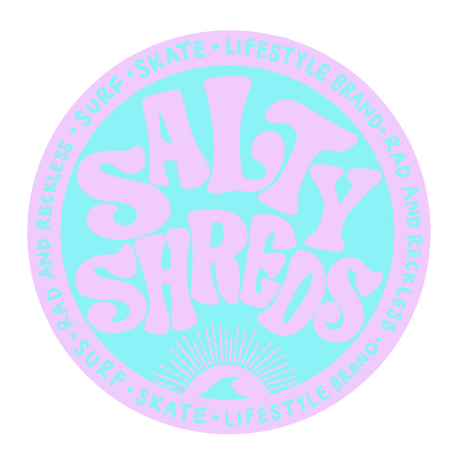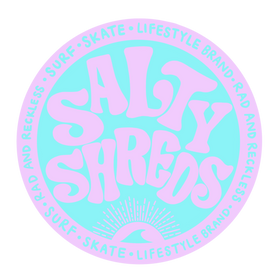Stylish' Shredding in the Rad Women Collection.
The Different Types of Surf Breaks
There’s a whole lot of waves out there, and when you learn how to surf, one thing is certain: You want to ride every dang one of them!
Surf spots across the globe produce waves with unique personalities, no two ever the same, each altered by various factors like the bottom of the seafloor, wind protection barriers, landmasses, and so much more. In categorizing a few of these major attributes, surfers can then define a surf break as a particular ‘type’, known as:
- Beach Breaks
- Point Breaks
- Reef Breaks
These three major types of surf breaks make up nearly all the wonderful waves in the world. So what exactly are they, and why does it matter what kind of wave you’re surfing? I’ll hit on everything there is to know about the different types of surf breaks, and expand a bit on some of the more “unspoken” types of waves, as I like to say there’s more than just the famous three!
Check it.
What is a Surf Break?
A surf break is essentially referencing the type of wave produced at a particular, surfable location. If someone asks you “what type of wave is it?” when talking about a surf spot, they’re really asking what kind of surf break it is, and categorizing a surf break is a way of identifying what the wave breaks over and therefore the personality of the wave.
When a swell reaches the coast, its energy breaks into rideable surf when making contact with the bottom of the seafloor or a landmass. The energy is forced upward, lifting the water with it, and down it breaks into whitewash and, hopefully, a surfable wave face. With all sorts of variations to how this happens, different surf breaks will produce very different waves.
So, when you’re searching for waves, every spot you check has the chance to be an entirely different type of break than the spot down the road. But knowing what kind of surf break it is will give you insight to ideal conditions, ie; what swell types/directions work best, ideal winds, wave size/style, and more. I suggest digging into my article on how to read a surf report to learn more about that must-have surfing knowledge.
The type of surf break will give insight as to a waves personality and what to expect well before you ride it, and it’s a good way to categorize surf locations across the world. Here’s what this all means.
The Three Main Types of Surf Breaks
1. Beach Breaks
A classic, uncrowded beach break with multiple peaks to sit on.
A beach break refers to a surf spot in which a swell’s energy breaks over sand, typically sand that has collected into a definitive sandbar. Overall, beach breaks are the most volatile of all the surf breaks, but also the most common.
By volatile, I mean that the ocean floor is always changing. The sandbar(s) that the wave breaks over at a particular location are always shifting, so beach breaks often change personality, and there’s typically multiple peaks to identify at a single surf spot that can always change, too.
Beach breaks also change very acutely during short time-windows. A beach break at high tide might produce a clean, mellow wave, whereas at low tide it can turn into a churning barrel. Because they often face bigger stretches of coastline, they’re pretty susceptible to winds.
Although all of these factors might seem like a bad thing, it’s really not. Beach breaks prodive the most consistency, as they don’t require ultra-pattrulclar swell directions to work. When the waves are mellow, they’re the safest type of wave to ride, and for beginner surfers + the groms, I highly suggest looking for a beach break. Surfing over sand is always less intimidating than a shallow, sharp reef!
But when conditions are large, beach breaks can get dicey and hard to navigate. There’s not often a clear place to paddle out, and you’ll have to duckdive straight past the impact zone in order to make it to the lineup. The reward, though, is always worth it.
2. Reef Breaks
Where a beach break identifies a wave that breaks over sand, a reef break is one that breaks over a reef or rock! Simple enough, right? But what’s the real difference?
A reef break has the chance to produce an extremely good, clean breaking wave, but it requires a swell direction that works with the position of the reef.
Whereas sandbars can shift and change, reefs don’t move much!
With this, reef breaks are great because you can really know what to expect from the surf forecast, and there's a higher level of predictability based on certain swell directions.
It's a common characteristic that reef breaks flaunt some of the best barrels in the world, as these seafloors can handle and hold up the incredible size of big, powerful waves. We’re talking Pipeline, Teahupoo, and Cloudbreak just to name a few of the best, biggest, and deadliest waves in the world.
Although there’s a handful of beach breaks out there with huge barrels, like Playa Zicatela in Puerto Escondido, most other sandbars get totally destroyed by significant swells and require time to build back up. So if you’re looking for barrels, there’s a good chance it's going to be over a reef or rock.
However, reef breaks aren’t all blue water, sunshine, and smiles. A lot of the time, these surf spots only work during lower tides, and break over extremely shallow (sometimes even exposed!) reef. Of all the different types of surf breaks, reef breaks are the most dangerous. That said, you can still find plenty of reef breaks with smaller, safe waves.
So before surfing a reef break, you need to study and learn the spot, and ensure your skill levels are ‘up-to-date’ before dropping in over three feet of water. This means understanding how deep the water is during certain tides, where any dangerous areas of the reef are, and overall maintaining the ability to surf with confidence.
The good news is that, because of their set location, reef breaks often feature a channel of open water where the waves do not break, giving surfers a set, easy place to paddle out. Or even a place for boats to watch the show!
3. Point Breaks
Point breaks typically 'bend' as they break off a landmass.
Point breaks and surfers have quite the love affair, as this type of surf break produces some of the cleanest, longest, fastest, and most rippable waves in the world. A point break wave is one that first breaks off a protruding landmass/headland and continues breaking into a curved bay. A point break wave will only break in ONE, never-changing direction, so you always know what you’re going to get, but requires a very particular swell direction in order to work well.
Point breaks might have a reef, rock, or sand bottom. So yes, technically one could be considered a reef break and a point break.
These surf spots are great because of their easy paddle out; you can literally walk back to the point or paddle entirely around the waves, but they can also get a bit crowded, as there’s only one peak to sit one and one line to ride.
Sometimes, the good surfers will crowd the main peak, which is where the waves first start breaking closest to the point, while other, less experienced surfers sit further inside the cove. This way, they can watch the other surfers catch the waves, and if one falls, take the opportunity to ride the second half of the wave.
Other, Less Talked About Types of Surf Breaks
The above-mentioned types of surf breaks cover 99% of all the surf spots in the world, but there's a few other, super unique surf spots worth mentioning. These are a more ‘unconventional’ type of surf break, but it goes to show you how creative you can be with surfing, and how there’s never any set definition to what riding a wave means or how that can be achieved!!
1. River Breaks!
Ever heard of riding a stand-still wave on a river? River surfing is a radical approach to wave riding, and when the water is rushing, produces an endless wave. One of the more famous river waves is in Germany, where surfers share the stoke as they carve this fast-moving, backwards rushing water all day long. With so many rivers in the world, it’s safe to say this is probably one of the more unexplored forms of surfing. Who knows how many undiscovered river breaks are out there waiting!
2. Tidal Bores
Tidal bores are technically river breaks, but instead of riding on a set area of water breaking over rock, you actually ride a wave produced by a tidal bore. These waves are some of the longest waves ever ridden, but they’re like diamonds in the ruff. Hard to find, super intimidating, and they only happen with the perfect weather + tide conditions.
3. Shore Breaks
What is a shore break? It’s a wave that breaks directly on the shore, typically closing out in one wild display of water crashing against sand. You can’t really surf a shorebreak, although some surfers will always push the limits and drop into mad closeout barrels with their soft tops, directly on shore.
But then, of course, there’s skimboarding! And skimboarders are masters of a shore break, surfing the shore with style and skate-like prowess as they hit the lip, get barreled, and pop-shuv onto the sand.
4. Man Made Waves!
Life is crazy, and you can now find world-class waves in landlocked places. There’s man made surf breaks popping up all over the place, like Surf Lakes in Australia, each featuring a unique type of technology producing a very unique wave. These waves are perfect, customizable, and break on the push of a button. Not bad for our landlocked surfer friends, they’re ideal for competitive surf training, and who's complaining about a wave they can ride whenever the ocean goes flat?!
5. Boat Waves!
Whether you're surfing the wake of a massive cruise ship moving through a channel or wakesurfing with a rope, there’s all sorts of boat waves out there to rip and keep you busy.
Hello to all my salty people! Thanks for readin' my blog and for the continuous support towards our brand. Make sure to sign up to our newsletter by creating your account to stay in the loop with new releases, sales & giveaways, and all our future blog post!
Live rad, stay salty.
- Ash, Dev & The Salty Shreds Fam.

